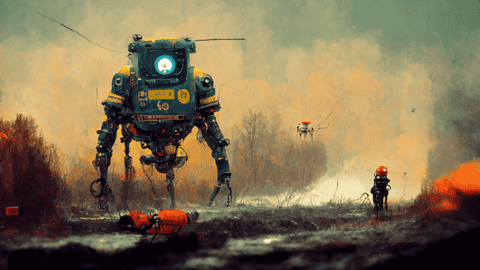The huge impact of artificial intelligence (AI) and machine learning (ML) in today’s society is becoming apparent. When saying this, we want to drive your attention to how AI can save lives. These two are changing markets and how we think about our lives. AI and ML are becoming key in spotting issues early, helping, and overall wellness. They’re amazing at handling tons of data and smart decisions.
1. How AI Can Save Lives Through Diagnosis and Research
Common non-infectious illnesses cause many global deaths. We see how AI can save lives by helping people live longer and healthier. AI is helping to make faster and more accurate diagnoses by analyzing medical data. This is clear in medical images. AI can understand lung or breast pictures in minutes, showing its power to find issues like cancer. AI can do better than doctors sometimes, showing how it can save lives.
The role of AI does not end with diagnosis. AI’s a big deal in medical research and making drugs. AI’s studying how molecules interact speeds up finding possible treatments. AI does paperwork with no human help and lets scholars focus on key tasks. AI can speed up the research process.
2. Reducing Medical Errors and Saving Lives with AI
Mistakes in medicine cause many deaths. The potential of how AI can save lives is its ability to act as a safeguard within the healthcare system. AI and staff team up, fixing medicine errors together. AI is constant, avoids lapses, and cuts errors, unlike humans. Another cool thing about AI is real-time monitoring, which identifies crises based on patients’ vital signs and predicts events such as heart attacks and strokes in advance.
3. Fair Healthcare Access: How AI Can Save Lives Globally
The global healthcare gap is huge, with certain places suffering from a lack of medical services. AI is tackling this problem by bringing healthcare to areas where it lacks. Mobile apps connect patients with doctors remotely, providing diagnostic assistance for a variety of conditions. AI-powered diagnostic tools use digital images to analyze skin conditions, burns, and chronic wounds. This is a good way to fill the gap left by inadequate local medical resources.
AI is also important in delivering medical supplies to rural areas with little infrastructure. AI-enabled drones, such as those coming our way from Zipline, facilitate the timely delivery of critical supplies such as vaccines and blood. Mixing new tech with healthcare goes beyond borders, saving lives.
4. AI: Advancing Traffic Safety and Saving Lives
Mistakes by people still lead to deadly road crashes and serious harm. The potential of how AI can save lives extends to traffic safety by improving both human-driven and self-driving cars. AI-powered self-driving cars have the potential to reduce accidents by taking the human margin for error to zero. Until then, AI-enabled driving improves vehicle safety through real-time monitoring.
5. Enhancing Healthcare Delivery and Intervention with AI
AI’s impact on healthcare delivery and intervention demonstrates how AI can save lives. AI aids healthcare by spotting patients needing care, bettering results, and cutting costs. AI cuts infections, predicts chronic diseases, and improves care.
Covid-19’s urgency shows AI’s value. AI tracks immunity and speeds up vaccines. Its data boost diagnosis and treatment, saving lives.
6. AI: A Lifesaver in Detecting Medical Conditions
The ability of AI to save lives outside of typical healthcare settings is evident in the recognition of medical crises. Corti’s AI spots heart attacks in 911 calls and helps outside hospitals. AI quickly assesses a caller’s medical status by analyzing voice patterns and content, increasing survival rates for time-sensitive conditions.
7. AI: Changing How We Handle Diseases and Medicine
AI changes drug research, predicts how diseases worsen and improves treatments. ML provides models that predict disease growth and treatment outcomes. Clinical Knowledgebase (CKB) initiatives are helping to speed up medical research by organizing and analyzing data from clinical trials, leading to more targeted medicines.
8. Addressing Human Trafficking: How AI Can Save Lives
AI has the capacity to tackle complex societal problems such as human trafficking. Stopping human trafficking needs sifting through lots of data to spot patterns and track wrongdoers and victims. AI is ideal when it comes to data mining, helping scholars combat this global threat. Groups like Code 8.7 use AI to find and stop traffickers, showing tech’s life-saving reach.
9. AI Aids Environment: A Lifeline for Marine Life
AI’s promise to save lives extends to protecting the environment. AI models are being used by firms such as The Ocean Cleanup to measure and monitor plastic waste in the oceans. AI helps save the planet. It studies data, and spots pollution patterns. Smart AI tech cleans oceans, reducing plastic pollution harm.
10. Guiding Health Research and Awareness Through AI
AI leads health research, tracks disease, speeds vaccines and spreads awareness. Adaptive Technologies and Microsoft deal shows the potential of AI to improve diagnosis, treatment, and prevention. The open data access website raises global health awareness by highlighting AI’s role in informed decision-making.
In conclusion, the potential of how AI can save lives is boundless. The impact of AI on human well-being is significant, from transforming healthcare to preventing accidents, treating disease, and addressing social issues. AI gets better and saves more lives. The future’s healthier, safer for all.
